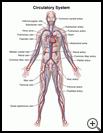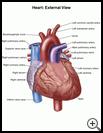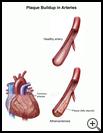
Heart Attack Discharge Information
What is a heart attack?
A heart attack, also called myocardial infarction or MI, happens when blood flow to a part of the heart is suddenly blocked, or a blood vessel in the heart suddenly squeezes and cuts off blood flow (called a spasm). You will feel pain called angina. The blood carries sugar (glucose) and oxygen to the heart muscle. As you get older, your heart arteries get narrowed by the buildup of plaque. Plaque is made up mostly of fat and cholesterol that sticks to the inside walls of the arteries. When the plaque breaks open, a blood clot forms, which blocks the flow of blood to the heart muscle. When blood doesn't reach the heart muscle, the muscle is damaged. Usually, part of the heart muscle dies. How much of your heart muscle dies depends on how long the blood flow was blocked and where.
How can I take care of myself when I go home?
There are things you can do now to take care of yourself and to prevent problems in the future. You need to make changes to be healthier and to help keep from having another heart attack. You will be encouraged to begin an exercise program, as well as eat a healthy diet and make other lifestyle changes to improve your health.
Management
- Your provider will give you a list of your medicines when you leave the hospital.
- Know your medicines. Know what they look like, how much you should take each time, how often you should take them, and why you take each one.
- Take your medicines exactly as your provider tells you to.
- Carry a list of your medicines in your wallet or purse. Include all nonprescription medicines and supplements on the list.
- Talk to your provider before you use any other medicines, including nonprescription medicines.
- Your provider may prescribe medicine to:
- Treat or prevent pain
- Dissolve or break down blood clots
- Prevent blood clots
- Relax and widen blood vessels and allow blood to flow through them easier
- Reduce blood pressure, slow the heart rate, and reduce the workload of the heart
- Control cholesterol levels
- Reduce fluid build-up and swelling in the body
- Reduce straining with a bowel movement
- Your provider may recommend other types of therapy to help relieve pain, other symptoms, or side effects of treatment.
- Ask your healthcare provider if you should take aspirin and if so, how much to take. Taking a low-dose aspirin every day may help prevent a heart attack or stroke. However, not everyone should take aspirin.
- You may need to continue cardiac rehabilitation therapy at home or at a skilled nursing facility to help you adjust to the activity limits you may have after your heart attack and to improve your health and fitness level. Most rehabilitation programs include:
- Physical therapy to help you regain muscle strength and teach you ways to move safely
- Occupational therapy to help you relearn ways to do the tasks that you previously did
- If you have had surgery, to care for your surgical wound:
- Keep your surgical wound clean.
- If you are told to change your dressing on your surgical wound, wash your hands before changing the dressing and after disposing of the dressing.
Appointments
- Follow your provider's instructions for follow-up appointments.
- Keep appointments for any testing you may need. For example, if you now take medicine to prevent blood clots, you will need to have regular blood tests.
Talk with your provider about any questions or concerns you have.
Diet, Exercise, and Other Lifestyle Changes
- Follow the treatment plan your healthcare provider prescribes.
- Follow activity restrictions, such as not driving or operating machinery, as recommended by your healthcare provider or pharmacist, especially if you are taking pain medicines or muscle relaxants.
- Get plenty of rest while you’re recovering. Try to get at least 7 to 9 hours of sleep each night.
- You will probably need to make changes in some of the foods you eat. Ask your provider about the benefits of talking to a dietician to learn what you need in a healthy diet.
- If your heart attack was caused by plaque build-up in your heart arteries, you will need to eat a diet low in sodium, low in cholesterol and high in fiber.
- Ask your healthcare provider if there are any foods or medicines you should avoid.
- Drink enough fluids to keep your urine light yellow in color, unless you are told to limit fluids.
- Lose weight if you need to and keep a healthy weight.
- Exercise as your provider recommends.
- Don't smoke. Smoking can worsen poor blood circulation.
- Find ways to make your life less stressful.
Call emergency medical services or 911 if you have new or worsening:
- Chest pain or pressure, squeezing, or fullness in the center of your chest that lasts more than few minutes, or goes away and comes back (may feel like indigestion or heartburn)
- Pain or discomfort in one or both arms or shoulders, or in your back, neck, jaw, or stomach
- Trouble breathing
- Breaking out in a cold sweat for no known reason
- If your provider has prescribed nitroglycerin for angina, pain that does not go away after taking your nitroglycerin as directed
- Along with the previous symptoms, feeling very tired, faint, or sick to your stomach
If you have any of these symptoms, do not drive yourself.
Call your healthcare provider if you have new or worsening:
- Dizziness or lightheadedness
- Inability to do your normal daily activities
- Feeling like your heart is beating too fast, too slow, or skipping beats
- Shortness of breath
- Sudden weight gain of 3 pounds in one day or 5 pounds in a week
- Swelling in your feet, ankles, or legs, or abdominal bloating, or swollen hands or face
- Signs of infection around your surgical wound if you had surgery. These include:
- The area around your wound is more red or painful
- Your wound area is very warm to touch
- You have blood, pus, or other fluid coming from the wound area
- You have a fever higher than 101.5° F (38.6° C)
- You have chills or muscle aches
- Signs of a problem when you are taking blood thinners, such as:
- Unusual bruising
- Red or black bowel movements
- Cuts that do not stop bleeding
Ask your healthcare provider about any medicine, treatment, or information that you do not understand.
Last modified: 2016-05-17
Last reviewed: 2016-05-16



